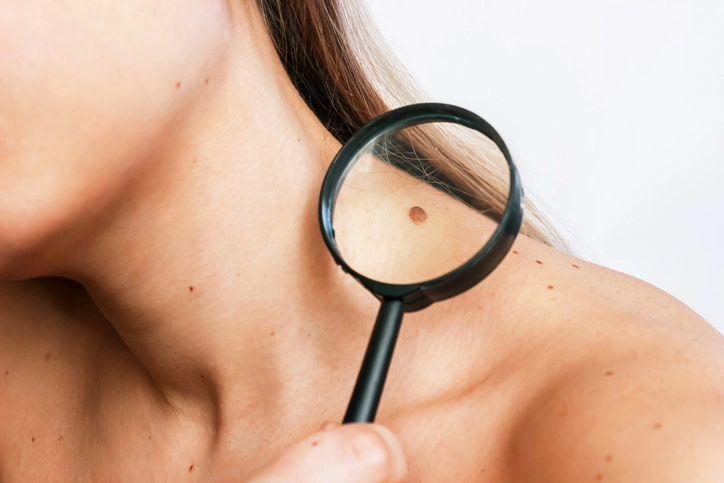
By: Kimberly Rodrigues
At 21 years old, Darcy, now 24, had a mole on her collarbone that was growing larger and darker, which was noticed by her mom who urged her to have it examined, leading to a startling diagnosis of the most lethal form of skin cancer.
“I was initially turned away by my GP who thought that the changes were nothing to worry about. Because I knew that something wasn’t right, I decided to go back again,” Darcy told Teenage Cancer Trust.
The mole was excised and analysed by medical professionals, resulting in a diagnosis of melanoma, an uncommon and dangerous form of skin cancer that has a high likelihood of spreading to other areas of the body, The Times of India informs.
According to Darcy’s statement to the Manchester Evening News, she was reportedly unfamiliar with melanoma and felt overwhelmed when informed by doctors that the mole was cancerous, expressing a desire for the floor to swallow her up.
“That was it and I just couldn’t take in anything else he was saying after that. I felt a bit numb,” she said.
What is melanoma?
Cleveland Clinic explains that melanoma which means “black tumour” is the most dangerous form of skin cancer. It increases rapidly and can metastasize to any organ.
Melanoma originates from melanocytes, skin cells that generate melanin, the dark pigment responsible for skin colouration.
Although most melanomas are black or brown, some may appear in other hues such as pink, red, purple, or skin-toned.
Approximately 30% of melanomas originate from pre-existing moles, while the remaining majority develop in normal skin. This emphasises the significance of monitoring changes in your skin, as most melanomas do not initially manifest as moles.
However, experts inform that the number of moles on your skin can serve as an indicator of your skin’s susceptibility to developing melanoma.
Identifying whether you are at high risk for melanoma is crucial, as the swift growth rate of melanomas implies that delaying treatment may have life-threatening consequences.
Being aware of your risk can reportedly prompt you to maintain a heightened level of vigilance in monitoring changes in your skin and seeking professional skin examinations since the chances of a full recovery increase to 99% if melanoma is detected in its initial stages.
Early detection is critical, as the success of treatment depends on the depth of the cancerous growth.
Causes & risks
Although the root cause of all melanomas is not entirely understood, research indicates that exposure to ultraviolet (UV) radiation emanating from sunlight or tanning lamps and beds raises the probability of developing melanoma.
So, reducing your exposure to UV radiation may diminish your likelihood of developing this form of cancer, the Mayo Clinic explains.
The incidence of melanoma appears to be rising in individuals under the age of 40, particularly among females. And according to experts, understanding the symptoms of skin cancer can aid in the early detection and management of cancerous alterations before they spread as an early diagnosis of melanoma reportedly enhances the likelihood of successful treatment.
Speaking about her diagnosis, Darcy is reported to have said that the medical professionals were “just as shocked” as she did not seem to possess any risk factors for developing melanoma.
She states, “I told them that I’d never had any bad sunburns. I’ve never been in a tanning bed; I do have the typical skin type that does have a lot of moles and has to be a bit more aware of their moles. Other than that, I don’t feel like I’d put myself at any kind of further risk of getting skin cancer.”
Darcy reportedly underwent her first surgical procedure to eliminate the cancerous cells. Subsequently, she underwent another surgery to eliminate a broader area surrounding the mole, which is supposedly typically performed to ensure that all cancerous cells are eliminated from the body.
She is quoted as saying, “I haven’t had any further treatment other than that, it was just a lot of scans to kind of make sure it hadn’t spread anywhere. It’s just all about monitoring now and checking my skin all the time.”
Urging youngsters to be aware of the dangers of the disease, Darcy told the Teenage Cancer Trust, “I had no idea about the signs and symptoms of cancer, so I would also encourage young people to familiarise themselves with them as it may save their life.”
Presently working as a teacher, Darcy’s outlook on life has improved considerably since receiving her diagnosis. “It just made me look at things a lot differently. I changed jobs not long after my diagnosis because I realised, I wanted to be doing something different and more rewarding, which is why I ended up becoming a teacher,” she said.
 [TheChamp-Sharing]
[TheChamp-Sharing]